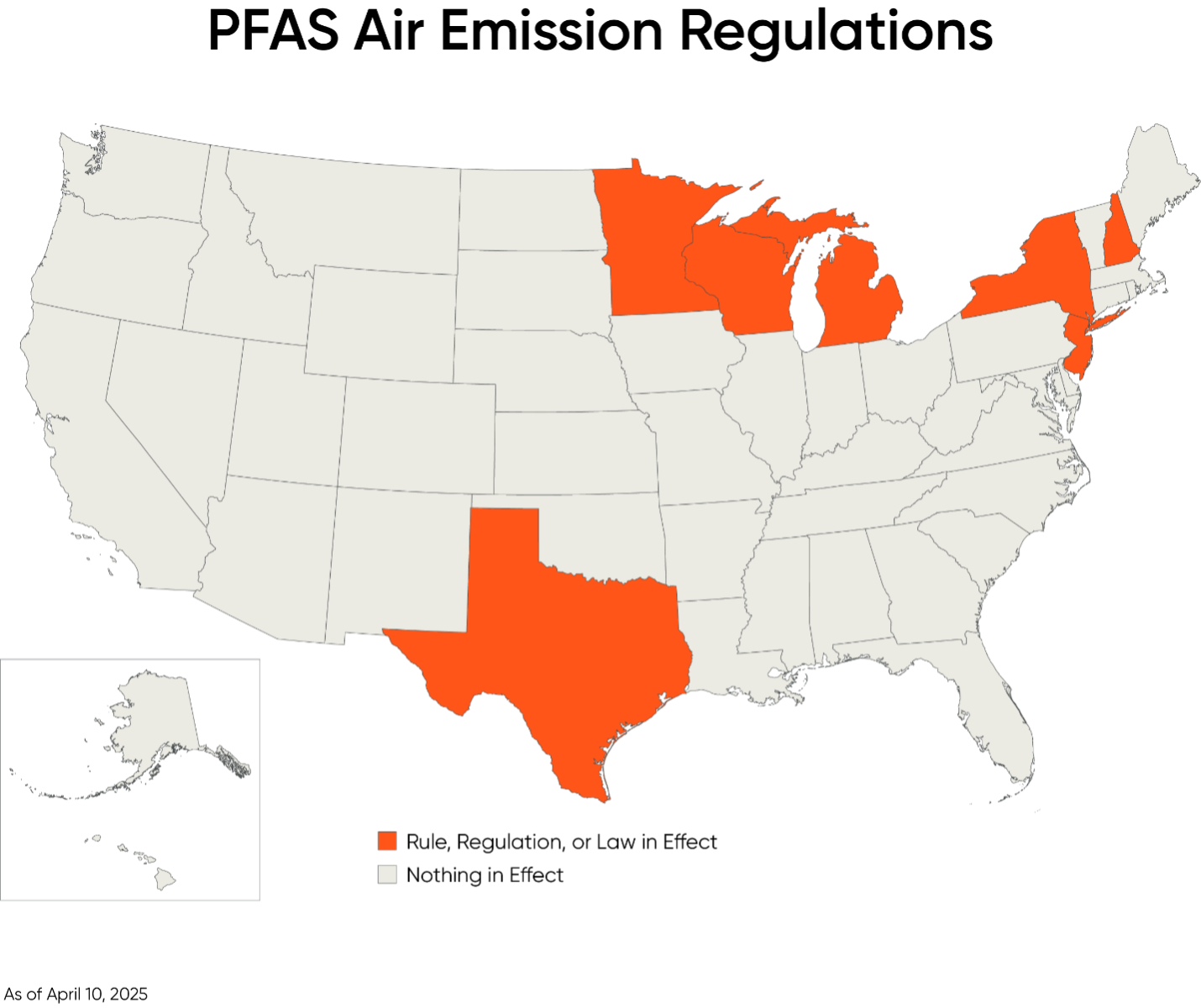BCLPemerging.com
PFAS Air Emissions Restrictions
Apr 17, 2025Summary
When evaluating legal risk relating to per- and polyfluoroalkyl substances (“PFAS”), most businesses typically consider wastewater, groundwater, or soil impacts, not air emissions. However, state and federal regulatory agencies have increasingly considered whether PFAS in air emissions affect the environment, paving the path for future emission controls.
This article outlines the legal and policy developments at the state and federal level that relate to PFAS in air emissions to help businesses mitigate risk and anticipate changes that may impact their operations.
Federal activity
Although there are currently no federally enforceable regulations limiting PFAS in air emissions, there have been several actions and publications that indicate federal regulations may be on the horizon:
PFAS Strategic Roadmap
The 2021 PFAS Strategic Roadmap identified the regulation of PFAS as a priority and committed EPA’s resources to developing the technical foundation as a first step towards the regulation of PFAS air emissions (see page 18). Although the prioritization of PFAS regulation may change under the Trump Administration, the proposed rulemakings, relevant guidance, and other technical documents issued pursuant to the Strategic Roadmap provide states and future federal administrations with a blueprint for regulation.
Air Emissions Reporting Requirements
On August 9, 2023, EPA proposed updating the Air Emissions Reporting Requirements (“AERR”) in a number of different ways including with its proposed “PFAS Option.” EPA solicited public comments regarding whether and how PFAS air emissions should be reported under the AERR. EPA suggested requiring reporting for the list of PFAS compounds that have already been added to the TRI list, and only when the annual actual emissions for the specific PFAS compound exceeded the TRI reporting threshold. Depending on how low the reporting threshold is for a particular PFAS compound, it may be a challenge for existing testing methods to accurately determine the annual actual emissions of the PFAS compound. In January of 2025, the Trump Administration published an Executive Order “freezing” all proposed federal actions pending the new administration’s review, including this rule.
Draft Air Emissions Test Method
Released in January of 2024, OTM-50 is a testing method for quantifying certain PFAS compounds in air emissions. EPA also issued a frequently asked questions document elaborating on the mechanics of its implementation. OTM-50 is not an official EPA testing methodology that has gone through public notice and comment.
OTM-50 attempts to provide a consistent method for use by the facilities, stationary source test teams, research laboratories, and other stakeholders to measure a common list of volatile fluorinated compounds (“VFCs”) emitted from vents and stacks. The method detection limits (measured in parts per billion, or “ppb” by volume) and quantitative reporting limits (measured in micrograms per cubic meter) are included for each VFC covered by this new test methodology. The specific OTM-50 detection and quantitative reporting limits are listed in Table 2.
The implication of a consistent testing methodology is significant, as state and federal agencies will likely use OTM-50 as a precursor to further regulation. For example, OTM-50 can purportedly be used to assess the efficacy of PFAS decomposition from thermal treatment control technologies. Accordingly, this methodology may assist EPA in drafting a final destruction and disposal guideline. On April 8, 2024, EPA issued an interim document, accompanied by a press release and a fact sheet, which called for more data regarding the thermal treatment of PFAS.
Regulated industries will want to closely review the science and technology behind any testing standard that attempts to measure VFCs at low ppb levels because those methods may not be able to consistently measure VFCs at the identified thresholds. Where constituents may be present at levels that cannot be consistently and accurately detected, this would result in an agency’s reliance on detection limits by default rather than actual measurements, which has important implications for permitting. In addition, measuring constituents at these levels may also require testing firms that have specialized equipment and laboratories that are able to process the results from a new standard, both of which are not always readily available.
In addition to OTM-50, an ASTM standard (D8560-24) was issued that discusses methods for determining PFAS concentrations in indoor air. At this time, it is unclear how the ASTM standard will affect emission testing methods, emission controls, and/or remediation efforts given that most regulatory focus is currently on aerial deposition into the environment.
Hazardous Air Pollutants
In December of 2023, a member of the House of Representatives proposed a bill that would list all PFAS substances “with at least one fully fluorinated carbon atom” as Hazardous Air Pollutants (“HAPs”) under the Clean Air Act. In August of 2024, North Carolina, New Jersey, and New Mexico filed a petition to EPA to add four PFAS substances (PFOA, PFOS, PFNA, and HFPO-DA) as HAPs under Section 112(b)(3) of the Clean Air Act. EPA has eighteen months to respond to the multi-state petition. If designated as HAPs, PFAS emissions would be subject to enforceable technology-based emissions limits through Maximum Achievable Control Technology or Generally Available Control Technology, in addition to other CAA permitting requirements. Notably, PFAS listed as HAPs would also be designated as Hazardous Substances under CERCLA, which could expand the list of PFAS compounds regulated under CERCLA.
State Efforts to Address PFAS in Air Emissions
As of the date of this publication, seven states have issued a regulation, rule, or other health-based standard addressing PFAS in air emissions, which is a trend likely to continue with federal inaction. Other states, such as Connecticut, have indicated a desire to develop PFAS air emission standards once accepted methods to quantify PFAS air emissions are adopted. The current state actions vary significantly both in terms of their form (e.g., guidance documents, screening levels, and/or ambient air limits) as well as the concentrations that they establish for different PFAS compounds, complicating compliance determinations and demonstrating that is area is evolving.
The information below is current as of April 10, 2025.

Description
Screening Levels. Michigan has developed specific screening levels for PFAS substances in the air to address human health and environmental concerns and to evaluate potential air permit and/or control requirements as necessary.
- PFOA: 0.0001 μg/m3 (applies to a 24-hour averaging period)
- PFOS: 0.0004 μg/m3 (applies to a 24-hour averaging period)
- 6:2 FTSA (Fluorotelomer Sulfonic Acid): 1 μg/m3 (applies to an annual averaging period)
Resources
Description
Risk Assessment Advice. Minnesota has developed Risk Assessment Advice to evaluate health risks due to PFAS substances in the air, usually based on technical information or chemical reviews. The Minnesota Pollution Control Agency may take exposures above these values into consideration with respect to, among other things, risk assessment and permitting.
- PFOS: 0.011 μg/m3 (short-term, subchronic, and chronic);
- PFHxS: 0.034 μg/m3 (short-term, subchronic, and chronic);
- PFOA: 0.063 μg/m3 (short-term, subchronic, and chronic);
- PFBS: 0.3 μg/m3 (short-term, subchronic, and chronic);
- PFHxA: 1 μg/m3 (short-term) and 0.5 μg/m3(subchronic and chronic); and
- PFBA: 10 μg/m3 (short-term, subchronic, and chronic)
- Short-term: Repeated dosing for more than 24-hours, up to 30 days
- Subchronic: Repeated dosing for more than 30 days, less than 8 years
- Chronic: Repeated dosing for more than 8 years
Resources
Description
Ambient Air Limit. New Hampshire has developed Ambient Air Limits (AALs) to promote public health by reducing human exposure to toxic air pollutants such as APFO. AALs are enforceable in New Hampshire’s regulations and must be met.
- APFO (Ammonium Perfluooctanoate): 0.05 μg/m3 (for a 24-hour averaging period) and 0.024 μg/m3 (for an annual averaging period)
Resources
Description
Initial Threshold Screening Levels (ITSL) and Reference Concentrations (RfC). The NJ Department of Environmental Protection applied values from EPA and MI to develop the values noted below.
- PFOA and PFOS ITSLs: 0.07 μg/m3 (combined or individually; applies to a 24-hour averaging period)
- GenX RfC: 0.01 µg/m3
Resources
Description
Annual Guideline Concentration (“AGC”). New York has developed AGCs, which are guidance values that control contaminants from process emission sources and would be evaluated as part of NYSDEC’s permitting process.
- PFOA: 0.0053 μg/m3 (for an annual averaging period)
- 2025 Proposed Law regulating PFAS as a “high toxicity air contaminant”
Resources
- New York State Department of Environmental Conservation Guidelines (See Table, pg. 15)
Description
Oral Reference Dose (RfD). Texas has developed RfDs to evaluate the potential exposure of concentrations of constituents in the air, usually utilized during the permitting process to determine if further evaluation is warranted.
- PFOS: 0.1 μg/m3 (applies to a 24-hour averaging period) and 0.01 μg/m3(applies to an annual averaging period)
- PFOA: 0.05 μg/m3 (applies to a 24-hour averaging period) and 0.005 μg/m3(applies to an annual averaging period)
- APFO: 0.1 μg/m3 (applies to a 24-hour averaging period) and 0.01 μg/m3(applies to an annual averaging period)
Resources
Description
Hazardous Air Contaminants. Two PFAS substances, AFPO and Perfluoroisobutylene (PFIB), are regulated as hazardous air contaminant; the emission standards below are enforceable
- APFO: 0.24 μg/m3 as a 24-hour average
- PFIB: 8.18 μg/m3 as a 1-hour average
Resources
How Is My Business Affected?
State and federal regulation of PFAS in air emissions may have costly implications for impacted businesses. Below are some factors to consider as you manage your business’ risk from future regulation of PFAS in air emissions.
Expanding applicability
Initially, EPA and other agencies were narrowly focused on a smaller set of sources for PFAS air emissions, such as metal finishing and plating industries. Recent data suggests that PFAS substances can be released into the air through air emissions stacks in certain industrial scenarios, and businesses should closely monitor developments within their state to determine whether their operations may become subject to monitoring, reporting, and possibly emission limit requirements.
Growing Scope of Regulations
The regulation of PFAS substances in air emissions is expected to continue expanding over the next few years as regulators develop a better understanding of the types and volumes of PFAS substances in industrial air emissions and testing methods become more refined. The development of OTM-50 purportedly serves to measure roughly 30 compounds which could significantly expand the scope of regulated compounds.
Air Permits
Evaluating PFAS risk as part of the air permitting process is a trend that has become increasingly popular among the states. For example, for several of the states referenced herein, if facilities exceed the screening levels or other relevant limits noted, the facilities could be required to further evaluate the impact of PFAS substances in air emissions, which can potentially lead to permit limits and/or control requirements. Although only a small number of facilities would purportedly exceed the various screening levels already developed in these states, the permitting process for those sources that trigger review (e.g., modified or new sources) may cause operational delays and potentially unanticipated capital expenditures. Additionally, the underlying basis for establishing permit limits or requiring controls may be questionable if the emission limits fall below the minimum detection limits in which OTM-50 is able to accurately identify PFAS compounds.
Conclusion
The regulation of PFAS substances in air emissions has already begun at the state level, and is expected to increase as additional data is gathered on PFAS concentrations in emissions.
For more information on PFAS chemicals, and the regulatory and litigation risks that they pose, please visit our PFAS webpage. If you have a question about how to manage PFAS risk in any jurisdiction, contact Tom Lee, Thor Ketzback, Daron Ravenborg, John Kindschuh, or any other member of our PFAS team at BCLP.
Related Practice Areas
-
PFAS Team






